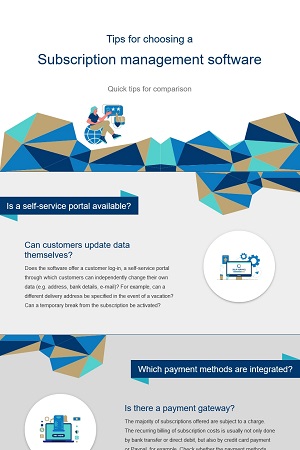The core of the subscription management software is the customer or subscriber management. The software solution should be able to manage customer relationships as automatically and flexibly as possible. All subscription products and contracts are managed via the subscription management. The respective prices for the subscription products are stored here, and upgrades and downgrades, discounts, terms and deadlines are managed.
-
Self-service portal

An important component of efficient and modern subscription management software is the self-service portal. Here, customers can make changes to their own customer data, view contract data, or download invoices, for example, regardless of location and around the clock.
-
Recurring billing

A subscription is associated with recurring deliveries (analog or digital). Accordingly, these deliveries are billed periodically depending on the subscription model, but also on a pro rata or consumption basis depending on the subscription product. The basis for these recurring billings is the customer's authorization for the collection of the amount, for example, by SEPA direct debit, credit card, or PayPal.
-
Recurring payments

Recurring payment is an automated procedure in which customers give a company permission to collect payments from their own credit card or account. This usually involves working with payment service providers, who handle the procedure and charge a transaction fee for it.
-
Dunning

An essential component of a subscription management software is the dunning system. A multi-level dunning system can be used to automatically send payment reminders and dunning letters. Escalation levels such as delivery stops, service restrictions, etc. can usually also be stored in the dunning area.
-
Marketing

Subscription management software usually also includes various sales functions, e.g. the marketing plan, the analysis of the sales situation, e-commerce functions, telemarketing, couponing.
-
Evaluations

Key figures and statistics ensure that the overview of sales, payments, cancellation and recovery rates, etc. is available. Identifying growth and churn in subscriber numbers helps in adjusting the product range and marketing strategy. With corresponding key figures, the appropriate conclusions can be drawn for successful further development of the business model.
-
Discount management

If the subscription management software includes discount management, you can efficiently and quickly configure absolute and percentage discounts or coupons. Price options can be stored for order forms, for example. Discount benefits are then clearly displayed to the customer during the ordering process. Discount codes are noted in the customer account when redeemed.
-
Interfaces

The subscription management software must be able to exchange data with a wide variety of systems, such as ERP, CRM, payment service providers, etc. Appropriate interfaces and data exchange formats are important for this.
 Thanks to knk subscription management, master data and various key figures can be more easily monitored, better applied and simply optimized. Publishing houses with recurring print and online media benefit from automated workflows and processes.
Thanks to knk subscription management, master data and various key figures can be more easily monitored, better applied and simply optimized. Publishing houses with recurring print and online media benefit from automated workflows and processes. Fakturia is the ideal solution for your subscription management and enables the automated creation of recurring invoices. As a Java EE application, it was developed specifically for the European market and offers flexible and easily scalable subscription management. The system keeps track of recurring services and consumption-based fees, with invoices due being sent automatically.
Fakturia is the ideal solution for your subscription management and enables the automated creation of recurring invoices. As a Java EE application, it was developed specifically for the European market and offers flexible and easily scalable subscription management. The system keeps track of recurring services and consumption-based fees, with invoices due being sent automatically. The Business Extension subscription software solution offers all important functionalities for the creation of offers through to the invoicing of subscriptions with a wide variety of business models. Use the professional solution for classic print subscriptions or digital subscriptions as well as for bookseller or association subscriptions, combined subscriptions and much more.
The Business Extension subscription software solution offers all important functionalities for the creation of offers through to the invoicing of subscriptions with a wide variety of business models. Use the professional solution for classic print subscriptions or digital subscriptions as well as for bookseller or association subscriptions, combined subscriptions and much more.